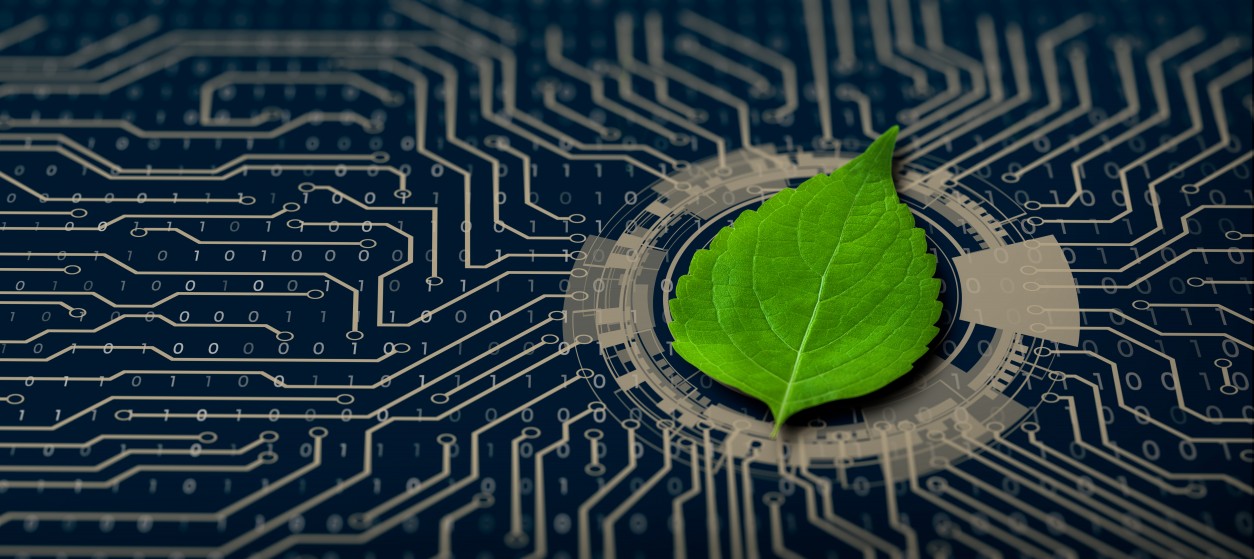During the past decade most enterprises started and advanced their digital transformation. It was the decade of the technology acceleration and the of the digital transformation of industrial enterprises. Nowadays, companies are prioritizing their sustainable development and their adaptation to the emerging climate change. In this direction, they leverage digital technologies to improve their sustainability and environmental performance. Hence, the current decade is characterized by the twin transformation of industrial enterprises, which includes digital and green aspects. In most cases, digital technologies are used to improve the economic performance and the eco-friendliness of business processes.
In this context, enterprises are seeking ways to improve the environmental performance of their IT operations. Hence, they integrate Green IT initiatives in their business processes. Green IT projects span hardware operations such as energy efficient data centers, and software operations such as green AI (Artificial Intelligence) libraries and software modules with optimized Input/Output cycles. Green IT initiatives and related sustainability solutions are usually part of a wider strategy for optimizing enterprise sustainability. This strategy includes IT and non-IT green practices, which are continually monitored based on tangible KPIs (Key Performance Indicators) such as carbon emissions indicators.
Political and Policy Drivers for Going Green
Green IT projects and other sustainability initiatives are driven by various factors. Many enterprises face tangible sustainability challenges, which put them under pressure to accelerate their green transformation. For instance, several manufacturers are striving to build a competitive advantage around the development of eco-friendly products. For instance, there are many cases where consumers prefer products that are manufactured based on sustainability best practices.
However, there is also a significant political push for improving enterprise sustainability. This political push is reflected on:
- Political agreements at the higher possible level, such as the Paris Agreement (or “Paris Climate Accords”), which is a 2015 international treaty on climate change. The agreement was negotiated between 196 counties and specifies actions for climate change mitigation, adaptation, and financial support.
- Regulations that specify environmental performance targets and incentivize sustainable behaviors by imposing regulatory penalties. For instance, the 2020 Energy code in NYC (New York City) requires that buildings over 25,000 square feet must reduce their greenhouse gas emissions by 40% by 2030. Penalties are foreseen for enterprises that will fail to meet this sustainability target.
In quest for exceptional environmental performance, modern enterprises take a holistic, integrated approach to pursuing ambitious sustainability targets. For example, they specify sustainability strategies that comprise tens of sustainability activities, ranging from the use of a recycling bin and incentives for economizing on water consumption, to strategies for energy savings (e.g., smart lighting systems) and the provision of green incentives to their employees.
Green IT Initiatives
As part of their holistic strategy to sustainability optimization, modern enterprises strive to minimize the carbon emissions of their IT operations. In this direction, they employ Green IT initiatives including:
- Green Data Centers: These are data centers that provide exceptional energy efficiency and therefore minimize the impact of IT operations on the environment. Green data centers comprise state of the art mechanical, lighting, electrical, and computer systems. They also use advanced technologies for data storage, management, and data operations, notably technologies that operate in energy efficient ways. Moreover, they are hosted in sustainable smart buildings and leverage renewable energy sources. Furthermore, they are built based on the minimum possible construction materials, which is another factor that boosts their environmental performance.
- Green Software: Nowadays there are also trends towards developing software applications that exhibit exceptional energy efficiency and minimum CO2 emissions. To develop green software systems, IT developers strive to minimize energy savvy operations like I/O (input/output) operations and their recursive execution. In recent years, Green Software Engineering is gaining momentum as an emerging software development discipline. It deals with principles, best practices, and blueprints for designing, developing, deploying, and executing green software applications.
- Green AI Deployments: During the last couple of years, the interest in Artificial Intelligence (AI) systems and applications is booming. Enterprises are increasingly leveraging machine learning techniques (including deep learning models) towards extracting knowledge and insights from large volumes of historic datasets. Machine learning programs are usually trained over large volume of historical data in order to learn how to extract knowledge and identify patterns in new unknown data points. In most cases, the training and execution processes are energy savvy. Specifically, they use many computing cycles based on supercomputing infrastructures that comprise GPU (Graph Processing Units) and TPU (Tensor Processing Units). Hence, state of the art AI produces many CO2 emissions and exhibits poor environment performance. To alleviate these effects, the AI community is working on novel energy efficient AI and machine learning paradigms. As a prominent example, there is an on-going shift of data from the cloud to the edge of the network, which reduces the intensity of training operations and economizes on CO2 emissions. For instance, the Federated Machine Learning paradigm enables the training of mini-models based on smaller datasets. Accordingly, it combines multiple mini-models into more accurate global models. This keeps machine learning training operations at the edge of the network and boosts environmental performance. Likewise, there are also embedded machine learning paradigms that execute machine learning models directly on CPU constrained devices and microcontrollers. Such paradigms reduce the number of data transfers and of related I/O operations, which leads to fewer CO2 emissions.
Alongside core Green IT practices, companies employ green technologies that enable Green IT operations. For instance, LED lighting is used in computer offices. LED lights provide substantial sustainability gains, as they obviate the need for incandescent lights like the conventional light bulbs. Likewise, they also use programmable thermostats, which save money and energy based on scheduling and automated adjustment of the ambient temperature. Recently, there is also a surge of interest in electric vehicles, which are increasingly comprising computers and connected devices. Similarly, Green IT deployments are used in conjunction with Industrial Internet of Things (IIoT) deployments that reduce waste and improve the sustainability of production operations in settings like manufacturing shopfloors, energy plants and oil refineries.
Overall, modern CIOs must leverage their digital transformation as a primary vehicle for realizing the green transformation of their enterprise. In this context, they must deploy green IT products and related sustainable services (e.g., low energy servers, power efficient data centers), while at the same time engaging in sustainable supply chains. Twin transformation is set to ensure energy efficient operations, provide cost-savings, and improve a company’s brand image. Therefore, it is at the very top of the strategic agendas of modern enterprises and CIOs are obliged to deliver it.







